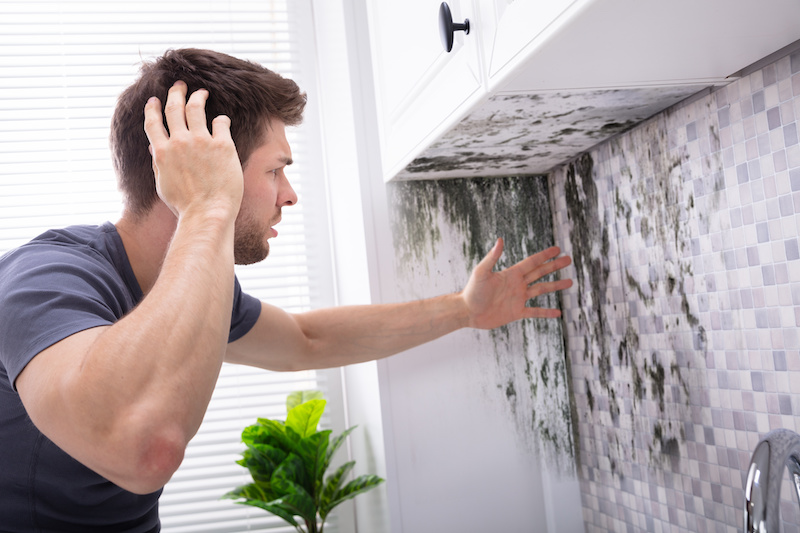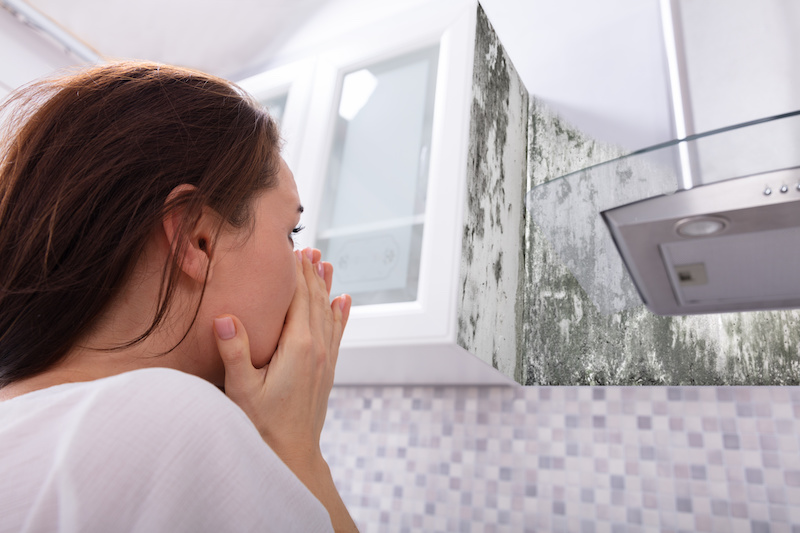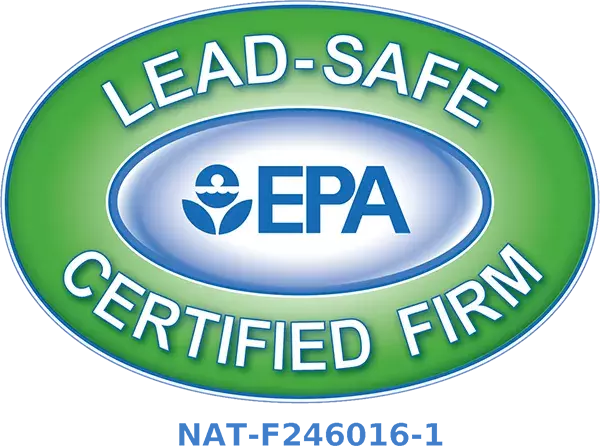Ever walked into a musty room and felt your nose twitch? Ever noticed black specks on the bathroom tiles, only to shrug it off? But what if those seemingly harmless signs were whispering about an unseen enemy – mold. The subtle yet relentless invader that could trigger symptoms of mold sickness.
In this invisible battle against mold spores, knowledge is our greatest weapon. It’s time we unmask these hidden culprits lurking in damp corners or behind peeling wallpaper. Time to understand how they sneak into our bodies, triggering sneezes, red eyes, and even serious health conditions.
We’re here to guide you through it all – recognizing early signs like coughs and allergies, understanding complex conditions such as hypersensitivity pneumonitis, seeking timely medical help, and even guiding you on how to effectively get rid of mold. Take a sigh of relief, we’re here to assist!
Table Of Contents:
- Understanding Mold Sickness and Its Impact
- Identifying Symptoms of Mold Sickness
- Respiratory Issues Linked to Mold Exposure
- The Connection Between Allergies and Mold Exposure
- Health Complications Associated with Mold Sickness
- Seeking Medical Help for Mold Sickness
- Prevention Strategies for Mold Sickness
- FAQs in Relation to Symptoms of Mold Sickness
- Conclusion
Understanding Mold Sickness and Its Impact
Mold sickness, particularly caused by toxic varieties like black mold, is a serious health concern. Exposure to toxic mold can cause a range of symptoms, depending on the individual’s physiology and amount of exposure. Black mold, for instance, prompts your immune system to react, often leading to an allergic response.

The exact nature of the symptoms varies among individuals due largely to their unique physiological makeup and the level of exposure they have had. For some people, mold illness might manifest as sneezing or coughing bouts while others could experience more debilitating conditions such as memory loss or even cognitive dysfunction.
Apart from immediate reactions following contact with molds like eye irritation and congestion, long-term effects may also surface. These include respiratory problems – imagine trying to breathe through a straw. This situation arises because exposure worsens asthma symptoms including wheezing, shortness of breath, and chest tightness, making life very uncomfortable.
Cognitive Symptoms of Mold Exposure
If you’ve ever walked into a room only to forget why you went there in the first place, then you’ll understand what it’s like when black mold impacts cognition – though much worse than simple absent-mindedness.
COPD, also known as ‘smoker’s lung’, can develop even in non-smokers when exposed to mold for extended periods of time. The link between this ailment and fungal contamination demonstrates just how insidious an enemy we face with molds lurking about our homes unnoticed.
Allergies Triggered By Molds: More Than Just A Sneezefest.
Sure, allergies can be annoying, but think again if you believe they’re just about itchy eyes and runny noses. Inhaling mold spores can trigger an allergic reaction that releases histamine into the body, leading to immediate allergy symptoms such as postnasal drip or nasal congestion.
Mold exposure can cause a variety of symptoms in different people, making it a sneaky and dangerous intruder. Whether you have pre-existing health conditions like asthma or not, the potential harm mold poses shouldn’t be overlooked.

Mold sickness, especially from toxic types like black mold, triggers various health problems – mild to severe. Symptoms differ per person due to individual physiology and exposure level. Some might experience simple sneezing or coughing, others may face memory loss or cognitive dysfunction. Prolonged exposure can lead to respiratory issues akin to breathing through a straw. Remember: Mold is not just an unsightly nuisance; it’s a serious risk that needs immediate attention for the sake of your health.
Identifying Symptoms of Mold Sickness
Mold sickness, especially from toxic molds like black mold, can cause a variety of symptoms. Knowing these signs is the first step toward getting the help you need.
Cognitive Symptoms of Mold Exposure
Studies have shown that exposure to certain types of mold can affect cognitive functions such as memory. This could result in difficulties with concentration or even feelings of confusion.
In addition to cognitive issues, common physical symptoms may occur due to prolonged exposure. These include sneezing, coughing, and nasal congestion often mistaken for a regular cold or allergy reaction.
Eye irritation is another prevalent symptom linked with mold allergies. If your eyes are red and itchy after spending time in damp areas where mold grows easily – this might be more than just an allergic reaction.
Skin Reactions and Other Physical Signs
Beyond respiratory distress and eye discomforts; skin reactions including rashes and hives may surface following direct contact with toxic molds such as black mold spores.
Fatigue also makes its way onto the list when talking about potential impacts on health. It’s not unusual for people affected by chronic obstructive pulmonary disease (COPD) triggered by high levels of fungal pollutants in their environment to experience severe exhaustion among other COPD related complaints like dry cough or wheezing breaths. Here’s what you should know about Black Mold Allergy.
The Importance Of Early Detection And Action Against Mold Illnesses
Avoid dismissing persistent postnasal drip or constant bouts of sneezing as merely seasonal allergies. Mold sickness symptoms might appear benign at first but can progress into more severe conditions like hypersensitivity pneumonitis if not addressed promptly.
Being aware of these symptoms and their potential severity is key to getting timely help. If you think your residence or work area may have a mold issue, it is advisable to enlist specialists for the removal of the mold. Remember – prevention is better than cure.
Spotting mold sickness early is crucial. Be alert for cognitive changes like memory issues, physical symptoms such as sneezing or coughing, and eye or skin irritations. Persistent fatigue could also signal a problem. Don’t brush off these signs – get help promptly to prevent serious health complications.
Respiratory Issues Linked to Mold Exposure
Mold exposure, particularly black mold, can have severe impacts on your respiratory health. It’s not merely a matter of sneezing or coughing; mold exposure can cause much more serious issues, such as exacerbating asthma symptoms, tightening in the chest region, and even lung bleeding.
When you breathe in mold spores, they may trigger an allergic reaction in your lungs. This reaction could lead to inflammation and constriction of the airways causing symptoms like wheezing, shortness of breath, and chest tightness – all classic signs of asthma.
The Impact on Asthmatics
If you’re already living with asthma, exposure to molds like black mold can make things worse. A damp environment that allows molds to thrive is a potential danger zone for asthmatics.
Key stat: Black mold exposure has been linked with triggering or worsening asthma symptoms such as wheezing and shortness of breath, according to research data.
Pulmonary Hemorrhage: A Rare but Serious Condition
A far less common but much more dangerous consequence of prolonged exposure is idiopathic pulmonary hemorrhage (IPH). IPH due specifically from black mold remains debated among scientists.
If you notice unusual respiratory issues paired with fatigue or unexplained weight loss following possible contact with high levels of indoor dampness and/or visible fungal growth areas — seek medical attention immediately. Don’t let “out-of-sight-out-of-mind” apply when it comes to these hidden threats lurking around corners within our homes.
Tackling Mold-Related Respiratory Problems
If you are experiencing respiratory problems due to mold exposure, it is important to take steps to reduce your exposure. First and foremost, get away from the source of exposure if possible. The more you breathe in these spores, the worse your symptoms may become.
If avoiding exposure isn’t an option or doesn’t alleviate symptoms, it’s time to seek professional help. Medical professionals can prescribe medications like asthma inhalers to manage asthma symptoms brought on by mold exposure.
The Best Defense is Prevention
It is essential to take precautions to prevent mold growth and safeguard those close to you.
Black mold exposure can seriously harm your respiratory health, causing conditions like worsened asthma and chest tightness. Rarely, it may lead to pulmonary hemorrhage – a serious condition that needs immediate medical attention. If you’re experiencing such symptoms after potential contact with damp or fungal growth areas, seek help right away. But remember: prevention is the best defense against these hidden threats. So always keep an eye out for signs of moisture build-up in your home to nip any possible mold problems in the bud.
The Connection Between Allergies and Mold Exposure
When you breathe in mold spores, your body might see them as invaders and fight back. Breathing in mold spores can provoke your body to respond with an allergic reaction, causing sneezing, coughing, a blocked nose, and watery eyes.
If you’ve ever spent time in a moldy environment only to start developing symptoms that seem suspiciously similar to allergies—this isn’t just a coincidence. You may be experiencing the impact of black mold exposure on your immune system.
Mold is everywhere; it’s part of our natural world. But when there are high levels inside homes or other enclosed spaces due to water leaks or damp areas causing excess growth—that’s where problems start.
Breathing Black Mold Spores Triggers Histamine Release
Your immune response goes into overdrive when you’re exposed to black mold spores. As these microscopic particles enter your respiratory tract, they can prompt your body to release histamines—a chemical known for its role in allergy responses. The result? A sudden onslaught of allergy-like symptoms such as nasal congestion or postnasal drip that leaves you reaching for relief measures.
Allergic Reactions Can Worsen Asthma Symptoms
Asthma sufferers often find their condition worsening after being around molds too long because the same substances triggering allergies also aggravate asthma pathways. If this sounds familiar – wheezing and shortness of breath after entering a room with visible mildew—you should definitely consider checking if molds are behind it.
Symptoms That Should Not Be Ignored
- Nasal Congestion
- Eye Irritation
- Sneezing
Take note if you experience eye irritation and sneezing in certain environments, as it could indicate an allergic reaction to mold exposure.
Preventing Mold Allergies and Asthma Attacks
Think about adopting preventative steps like managing water leaks and keeping good ventilation to lower your risk of mold-related allergies or asthma attacks. This strategy helps keep the moisture level low, making it harder for molds to thrive.
Exposure to mold spores can trigger your body’s immune response, causing allergy-like symptoms such as sneezing, coughing and eye irritation. This reaction is even more severe in asthma sufferers who may experience worsening conditions due to mold exposure. If you notice these symptoms in certain environments—it could be a sign of an allergic reaction to molds. To protect yourself from the harmful effects of mold, make sure you maintain good indoor air quality by using dehumidifiers or air purifiers, cleaning regularly, and promptly addressing any water damage.
Health Complications Associated with Mold Sickness
Asthma symptoms may worsen when you breathe in these spores. This is because your immune system reacts by releasing histamines that cause inflammation and congestion.
Black mold rarely causes serious illness or death but might exacerbate certain pre-existing conditions like asthma and allergies. But what’s even more intriguing? Not only physical symptoms such as body aches and red eyes but cognitive functions too are adversely affected by prolonged exposure to mold.
Research shows memory loss as one of the prominent signs of chronic mold toxicity. It gets scarier knowing how this could sneakily blend into everyday forgetfulness until it becomes significant enough for medical attention.
Pulmonary Conditions Worsened by Black Mold Exposure
Apart from allergy-induced issues, chronic obstructive pulmonary disease (COPD) sufferers often find their condition aggravated due to persistent black mold exposure – another solid reason why immediate remediation should be sought after identifying water damage at home or work.
This doesn’t stop here; other respiratory ailments such as idiopathic pulmonary hemorrhage have been linked to inhaling high levels of airborne molds too. However, remember that current evidence does not confirm acute idiopathic pulmonary hemorrhage directly resulting from black mold exposure alone.
Allergic Reactions Due To Molds
The common allergic reaction most people experience upon coming into contact with molds includes sneezing coughing fits along with skin rashes. The culprit behind these reactions? It’s histamine – a compound released by cells in response to injury and allergic or inflammatory reactions, causing contraction of smooth muscle and dilation of capillaries.
Interestingly, not everyone exposed to mold develops symptoms; some people are more susceptible due to genetic predisposition or weakened immune systems. In case you have been dealing with such persistent symptoms without an apparent reason, it might be a good idea to get your place checked for any hidden molds.
The Psychological Impact
Mood swings, slumber difficulties, worry and despondency can be the outcome of contact with poisonous mold. It’s crucial to be aware of this connection between toxic mold exposure and psychological distress.
Awareness and prompt action can help keep your health on track. Don’t let mold get the upper hand; protect yourself and your loved ones by staying vigilant to these mold symptoms.
Seeking Medical Help for Mold Sickness
If you’re battling symptoms like nasal congestion, dry cough, or hypersensitivity pneumonitis – these could be telltale signs of mold sickness. It is essential to get medical assistance promptly, as early detection can stop more severe illnesses such as chronic obstructive pulmonary disorder.
Mold toxicity isn’t something to take lightly. Your healthcare provider will likely ask about your family history and any exposure to damp areas where mold grows like basements or bathrooms with water leaks.
Diagnostic Tests for Mold Allergy
To confirm if it’s a case of black mold exposure causing your health woes, doctors might recommend several diagnostic tests. These may include skin prick tests or blood tests which measure specific antibodies in response to allergens, including black mold spores.
Bear in mind that while these are common methods used by physicians globally, there is no concrete evidence linking black mold exposure with acute idiopathic pulmonary hemorrhage. Cleveland Clinic reports, “There is no evidence that black mold exposure causes acute idiopathic pulmonary hemorrhage.”
Symptoms also tend to vary from person to person based on individual immune responses and the types of molds they’ve been exposed to. Some people may exhibit severe symptoms after spending time in extremely musty environments while others might only experience minor discomfort, even when exposed at the same level.
Taking Action Against Mold Exposure
If you suspect that you’re suffering from an allergy due to prolonged contact with toxic molds – don’t hesitate to seek medical attention. Inform your physician of any relevant symptoms and circumstances in which they appear.
Keeping mold at bay is crucial, and prevention plays a big role. Regular checks for water leaks and ensuring good ventilation by cracking open windows or using exhaust fans can significantly cut down the chances of mold growing in your home. As suggested by the Cleveland Clinic, “The best defense against mold allergy is to reduce exposure to specific types of mold that trigger reactions.” So make sure you’re proactive about it.
Don’t ignore symptoms like nasal congestion or dry cough as they could signal mold sickness. Early medical help can prevent serious conditions. To diagnose, doctors may use skin prick tests or blood tests to check for black mold exposure but remember, reactions vary from person to person. Stay proactive about reducing your exposure to molds at home by checking for water leaks and improving ventilation.
Prevention Strategies for Mold Sickness
By taking steps to prevent mold sickness, you can keep it from disrupting your life. It all starts with understanding how mold grows and what we can do to stop it.
The first line of defense against mold is controlling the moisture in your home. Cleveland Clinic advises that damp areas create a perfect environment for molds like black mold to thrive. So, fix those water leaks as soon as they start.
If you spot any ceiling tiles discoloring or wallpaper peeling off due to humidity, act immediately. Remember, these could be signs of hidden water leaks leading to potential mold growth.
Good Ventilation is Key
In addition to addressing water issues, good ventilation plays a crucial role in preventing molds from setting up shop in your house. Use exhaust fans in high-humidity areas such as bathrooms and kitchens; they help reduce condensation build-up on windows and walls where molds love growing.
Also, remember this: letting fresh air into your living space by opening windows whenever possible goes a long way towards reducing indoor humidity levels, which discourages pesky molds from settling down at your place. Isn’t that amazing?
Fighting Off Allergies
We know battling allergies isn’t exactly fun but hear us out: The best defense against allergic reactions caused by toxic spores involves minimizing exposure – just think about avoiding pollen during hay fever season.
The Cleveland Clinic suggests allergy shots might offer relief for people with severe symptoms too intense for over-the-counter medication alone. It’s not magic – just science doing its thing.
Start now to take control of your health and keep mold away. So, get started today and show those molds who’s boss.
Preventing mold sickness starts with controlling moisture and ensuring good ventilation in your home. Act swiftly on signs of water leaks or high humidity, as these create perfect conditions for molds like black mold to thrive. Allergy shots might offer relief if symptoms get severe. Every measure taken against mold is a step towards better health.
FAQs in Relation to Symptoms of Mold Sickness
How do I know if mold is making me sick?
If you’re often sneezing, coughing, or have a runny nose and red eyes without another cause, mold could be the culprit.
What does mold toxicity feel like?
Mold toxicity can make you feel constantly tired. It may also trigger headaches, dizziness, memory problems, and difficulty concentrating.
How long does it take for mold to make you feel sick?
Symptoms of mold sickness might appear within a few days after exposure. But they could also show up weeks later, depending on your sensitivity level.
Can mold in your house make you feel sick?
Absolutely. If there are black or other molds in your home that release spores into the air, they can lead to health issues when breathed in regularly.
Conclusion
Mold sickness is more than just a stuffy nose. It’s the sneezing, coughing, and red eyes that seem never-ending. In certain circumstances, it could even cause or exacerbate asthma issues.
Recognizing the signs of mold exposure early can save you from prolonged discomfort or severe health conditions like hypersensitivity pneumonitis. The key is to know what to look for – damp areas in your home where mold grows unnoticed; physical discomforts after spending time in musty environments; sudden allergic reactions.
If you experience persistent or severe symptoms, don’t hesitate to get medical assistance. Mold sickness isn’t something you have to face alone!
To keep yourself safe from these unseen enemies called molds? Keep your surroundings dry and well-ventilated – no water leaks unchecked! If mold does appear, act swiftly with removal measures because every moment counts when battling this persistent foe.
If you suspect that you have mold in your home, contact us at J&R Restoration immediately. Not only are we experts in mold removal, but we can also help with water damage, fire restoration, roof tarping, and interior remodeling.


